+ Open data
Open data
- Basic information
Basic information
| Entry | Database: PDB / ID: 2cvf | ||||||
|---|---|---|---|---|---|---|---|
| Title | Crystal structure of the RadB recombinase | ||||||
 Components Components | DNA repair and recombination protein radB | ||||||
 Keywords Keywords | DNA BINDING PROTEIN / RadB / filament formation / homologous recombination / ATPase domain / hyperthermophile | ||||||
| Function / homology |  Function and homology information Function and homology informationATP-dependent DNA damage sensor activity / DNA recombination / damaged DNA binding / DNA repair / ATP binding Similarity search - Function | ||||||
| Biological species |   Thermococcus kodakarensis (archaea) Thermococcus kodakarensis (archaea) | ||||||
| Method |  X-RAY DIFFRACTION / X-RAY DIFFRACTION /  MIR / Resolution: 2.6 Å MIR / Resolution: 2.6 Å | ||||||
 Authors Authors | Akiba, T. / Ishii, N. / Rashid, N. / Morikawa, M. / Imanaka, T. / Harata, K. | ||||||
 Citation Citation |  Journal: Nucleic Acids Res. / Year: 2005 Journal: Nucleic Acids Res. / Year: 2005Title: Structure of RadB recombinase from a hyperthermophilic archaeon, Thermococcus kodakaraensis KOD1: an implication for the formation of a near-7-fold helical assembly Authors: Akiba, T. / Ishii, N. / Rashid, N. / Morikawa, M. / Imanaka, T. / Harata, K. | ||||||
| History |
|
- Structure visualization
Structure visualization
| Structure viewer | Molecule:  Molmil Molmil Jmol/JSmol Jmol/JSmol |
|---|
- Downloads & links
Downloads & links
- Download
Download
| PDBx/mmCIF format |  2cvf.cif.gz 2cvf.cif.gz | 102.3 KB | Display |  PDBx/mmCIF format PDBx/mmCIF format |
|---|---|---|---|---|
| PDB format |  pdb2cvf.ent.gz pdb2cvf.ent.gz | 78.9 KB | Display |  PDB format PDB format |
| PDBx/mmJSON format |  2cvf.json.gz 2cvf.json.gz | Tree view |  PDBx/mmJSON format PDBx/mmJSON format | |
| Others |  Other downloads Other downloads |
-Validation report
| Summary document |  2cvf_validation.pdf.gz 2cvf_validation.pdf.gz | 434 KB | Display |  wwPDB validaton report wwPDB validaton report |
|---|---|---|---|---|
| Full document |  2cvf_full_validation.pdf.gz 2cvf_full_validation.pdf.gz | 484.6 KB | Display | |
| Data in XML |  2cvf_validation.xml.gz 2cvf_validation.xml.gz | 27 KB | Display | |
| Data in CIF |  2cvf_validation.cif.gz 2cvf_validation.cif.gz | 37.9 KB | Display | |
| Arichive directory |  https://data.pdbj.org/pub/pdb/validation_reports/cv/2cvf https://data.pdbj.org/pub/pdb/validation_reports/cv/2cvf ftp://data.pdbj.org/pub/pdb/validation_reports/cv/2cvf ftp://data.pdbj.org/pub/pdb/validation_reports/cv/2cvf | HTTPS FTP |
-Related structure data
- Links
Links
- Assembly
Assembly
| Deposited unit | 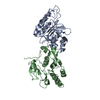
| ||||||||
|---|---|---|---|---|---|---|---|---|---|
| 1 | 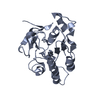
| ||||||||
| 2 | 
| ||||||||
| Unit cell |
|
- Components
Components
| #1: Protein | Mass: 24578.344 Da / Num. of mol.: 2 Source method: isolated from a genetically manipulated source Source: (gene. exp.)   Thermococcus kodakarensis (archaea) / Gene: Pk-REC / Plasmid: pET-8c / Production host: Thermococcus kodakarensis (archaea) / Gene: Pk-REC / Plasmid: pET-8c / Production host:  #2: Water | ChemComp-HOH / | |
|---|
-Experimental details
-Experiment
| Experiment | Method:  X-RAY DIFFRACTION / Number of used crystals: 1 X-RAY DIFFRACTION / Number of used crystals: 1 |
|---|
- Sample preparation
Sample preparation
| Crystal | Density Matthews: 2.2 Å3/Da / Density % sol: 42.8 % |
|---|---|
| Crystal grow | Temperature: 298 K / Method: vapor diffusion, hanging drop / pH: 4.6 Details: 0.2M ammonium sulphate, 30% polyethylene glycol monomethyl ether 2000, 0.1M acetate, pH 4.6, VAPOR DIFFUSION, HANGING DROP, temperature 298K |
-Data collection
| Diffraction | Mean temperature: 290 K |
|---|---|
| Diffraction source | Source:  ROTATING ANODE / Type: MACSCIENCE / Wavelength: 1.5418 Å ROTATING ANODE / Type: MACSCIENCE / Wavelength: 1.5418 Å |
| Detector | Type: BRUKER SMART 6000 / Detector: CCD / Date: May 11, 2002 / Details: Osmic Confocal Max-Flux optics |
| Radiation | Monochromator: Osmic Confocal Max-Flux optics / Protocol: SINGLE WAVELENGTH / Monochromatic (M) / Laue (L): M / Scattering type: x-ray |
| Radiation wavelength | Wavelength: 1.5418 Å / Relative weight: 1 |
| Reflection | Resolution: 2.4→24.7 Å / Num. obs: 16828 / % possible obs: 99.5 % / Observed criterion σ(I): 0 |
| Reflection shell | Resolution: 2.4→2.53 Å / % possible all: 98.7 |
- Processing
Processing
| Software |
| |||||||||||||||||||||
|---|---|---|---|---|---|---|---|---|---|---|---|---|---|---|---|---|---|---|---|---|---|---|
| Refinement | Method to determine structure:  MIR / Resolution: 2.6→6 Å / σ(F): 2 / Stereochemistry target values: Engh & Huber MIR / Resolution: 2.6→6 Å / σ(F): 2 / Stereochemistry target values: Engh & Huber
| |||||||||||||||||||||
| Refinement step | Cycle: LAST / Resolution: 2.6→6 Å
|
 Movie
Movie Controller
Controller





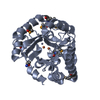
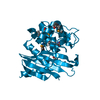
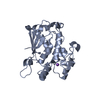

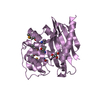


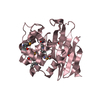
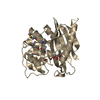
 PDBj
PDBj

